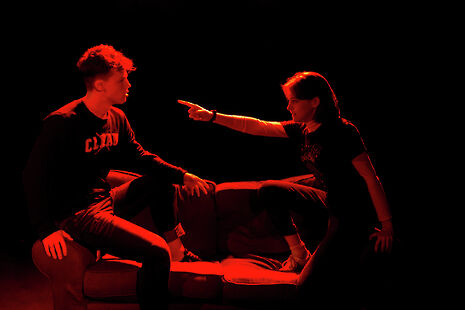Who’s Afraid of Virginia Woolf preview: ‘a play driven by emotional contrast’
Director Katie Woods brings theatre back to its basics in this tense and well-crafted classic

It’s 1950s New England. It’s 2am. Two couples stumble home from a party and set themselves up in the living room. The stage is set for a cosy family drama.
But Edward Albee’s after-party conversation is not harmonious or complimentary or relaxed. Rather, it breaks down into two hours of manipulative games, of jokes that teeter on the edge of humour and then smash off into the abyss, of dramatic consequences.
Either you know and love this play, or you’ve never seen it. Either way, Director Katie Woods has expectations to live up to. One of the main challenges, she tells me, has been to move her production away from the film version (1967, starring Elizabeth Taylor and Richard Burton), and to add her own physicality and meaning to the lines in a way which is not just an aping of the famous version.
Who’s Afraid of Virginia Woolf has been performed in Cambridge before, but always on the ADC stage. The claustrophobia (added to by next week’s heat) in the Corpus Playroom injects a new intensity to the production, an immediacy, as the audience are right there in the living room, experiencing the rollercoasters of emotion that form the shape of this play. In a play which is so dominated by physical interaction, having the audience on two sides liberates the actors. They can move wherever they like without having to worry that no one can see them. George’s erratic movements can be realised in their full distress, as he moves from the bar to the sofa and back again, facing up to one audience and then another. The characters circle around each other, getting nearer, pushing each other away, each taking the burden of anger one by one.
The dialogue is so well-crafted that every line feels like it is there for a reason
This is a play which is driven by emotional contrast, by sudden and definite shifts from stillness to anger to stubborn silence and round again. The characters are never in tune with each other – as one rises to anger, the other sinks into sullenness, and within a few minutes the situation has reversed itself. Language breaks down as the emotions rise and repetitions create not only a sense of these characters as human beings muddling through the world, but also a sense of melodrama.
It is the hints of melodrama which are most curious in this play. Woods tells me she was drawn to direct the play because of her interest in realist theatre, and her desire to bring theatre back to its basics, focusing on the characters and their emotions. It’s about feeling with the characters, tracing the explosions and withdrawals of their emotional outbursts to the very end of the play. The dialogue is so well-crafted that every line feels like it is there for a reason. Yet sometimes the realism in this play verges on the exaggerated, the melodramatic. One of the greatest challenges of this play is negotiating this line between the two generic spaces. Who’s Afraid of Virginia Woolf is a high-tension play, so it is important that the actors don’t start at 100%, Woods explains, because otherwise by the end there is nothing left to watch, and the audience loses interest. It’s about negotiating a balance, giving each line it’s full expansion but also refusing to indulge every one so that the story makes sense and the audience can cling on. To have an explosion of anger, you must have a silence either side.
Who’s Afraid of Virginia Woolf shows us four o’clock brokenness. It shows us an everyday scene stripped of its cosiness and formalities by the night and by alcohol, the instability of human emotion and the darkness behind the seemingly simplest relationships. It shows us the fragility of people. Martha’s eroticism becomes terrifying; George reading a book at four in the morning becomes a symbol of a life confused and out of order, and even as we watch their frantic and insane rollercoaster of emotions, the audience cannot help but feel sympathy for these intensely human characters. The tiniest things catalyse anger in this play but the secret realities this anger reveals are far from tiny.
Who’s Afraid of Virginia Woolf is on at the Corpus Playroom 8-12 May
 Features / Should I stay or should I go? Cambridge students and alumni reflect on how their memories stay with them15 December 2025
Features / Should I stay or should I go? Cambridge students and alumni reflect on how their memories stay with them15 December 2025 News / Cambridge study finds students learn better with notes than AI13 December 2025
News / Cambridge study finds students learn better with notes than AI13 December 2025 News / Dons warn PM about Vet School closure16 December 2025
News / Dons warn PM about Vet School closure16 December 2025 News / News In Brief: Michaelmas marriages, monogamous mammals, and messaging manipulation15 December 2025
News / News In Brief: Michaelmas marriages, monogamous mammals, and messaging manipulation15 December 2025 Comment / The magic of an eight-week term15 December 2025
Comment / The magic of an eight-week term15 December 2025








